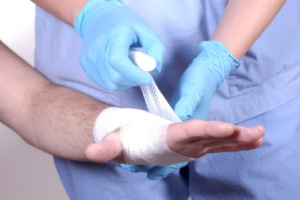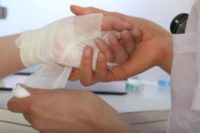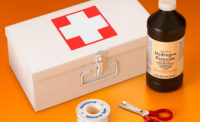 Many types of injuries can lead to compartment syndrome. Compartment syndrome is a condition in which there is swelling and an increase in pressure within a limited space (a compartment) that presses on and compromises blood vessels, nerves, and/or tendons that run through that compartment; and thus may cause death of all tissue in the compartment and other distal tissue. Although each digit has eight compartments, the syndrome rarely occurs in the hands, but should be kept in mind as a possible complication of hand injury.
Many types of injuries can lead to compartment syndrome. Compartment syndrome is a condition in which there is swelling and an increase in pressure within a limited space (a compartment) that presses on and compromises blood vessels, nerves, and/or tendons that run through that compartment; and thus may cause death of all tissue in the compartment and other distal tissue. Although each digit has eight compartments, the syndrome rarely occurs in the hands, but should be kept in mind as a possible complication of hand injury.
Lacerations, Dislocations, and Fractures (Broken Bones) Medical Treatment
Lacerations (cuts)
Evaluation of the depth or involvement of nerves, arteries, muscles, and tendons
Local anesthesia (numb the area)
Wound preparation - cleansing and irrigation, reexamination
Cleaning and removal of dead tissue
Dressing and splinting if necessary to keep the hand from moving
Pain medication
Antibiotics if needed (often a judgment call by the treating doctor)
Tetanus shot if indicated
Hand wounds that have not been treated prior to six to eight hours after initial injury may not need sutures. Many health care professionals leave these wounds open since they are sutured (closed) they are more prone to infection.
Internal damage: Lacerations that involve tendons can be treated at a later date by a hand surgeon with positive results. Therefore, an emergency department doctor may clean and close a hand laceration, then recommend tendon repair to a specialist at a later date.
Deep cuts: Some injuries require immediate treatment in the emergency department or surgically repaired. When an injury to an artery is diagnosed, a surgeon must evaluate for immediate surgical repair. If a large artery is cut, there is the possibility of massive blood loss. Death may result if bleeding is not controlled.
Bites: The main complication of bite wounds is infection. To help prevent infection bites (human bites or animal bites) require thorough cleansing and irrigation (washing out the wound). Puncture wounds (such as cat bites) and wounds where tissue is crushed (such as human bites and dog bites) are particularly likely to become infected. The risk of infection increases when these wounds are stitched closed, so most bite wounds need to be allowed to heal without stitches. The doctor may decide to loosely stitch large bite wounds. Most bite wounds require antibiotics and close follow-up to assure healing.
A common cause of a human bite wound is a fight in which a punch results in a cut on the hand caused by striking the opponent's teeth. When this "fight bite" is over a joint (usually the knuckle), cleaning the joint in the operating room may be necessary. This type of injury may appear minor, but can lead to severe deformity or disability even when appropriately treated. Consulting an orthopedic hand surgeon promptly about such bite wounds may benefit the patient.
Some hand lacerations are self-inflicted. After wound treatment, these patients should be referred to a psychiatric specialist.
Dislocations and fractures
Dislocations
Evaluation to determine extent of injury
Pain relief
X-ray to rule out fracture and further define injury
Local anesthesia
If there is no fracture or associated laceration, reduction to put bone back in place is attempted; reduced reduction of bones is painful, so some patients will require pain medication for the procedure.
Reexamination of the injury
Immobilization by splinting or budding taping
X-ray for confirmation of correct alignment
Follow-up with hand surgeon or orthopedist, usually within 24-48 hours.
Dislocations are the result of injuries to the ligaments around joints. In a dislocation, a bone is displaced out of normal position resulting in obvious deformity, pain, and decreased mobility. When a dislocation occurs, the doctor will evaluate the injury to ensure there are no fractures. Dislocated bones must be put back in place. This process is called reduction, which is the realignment of dislocated or broken bones. Reduction can be accomplished by external manipulation of the injured area (closed reduction) or by surgery (open reduction). All require follow-up care after a period of immobilization, usually with a splint or cast. The goal of treatment is to preserve the function and stability of the joint.
Splinting describes any method used to keep the injured hand or finger from moving. The doctor may place an injured hand or finger against a solid, stiff object but not inside a cast. With a splint the injured area is immobilized yet still has room to swell. A cast does not allow for swelling, so the injury may be casted a few days after swelling has decreased.
Buddy taping is a procedure where the doctor tapes an injured finger to an adjacent finger to keep the injured finger from moving. The other finger becomes a splint.
Fractures (broken bone)
Evaluation to determine extent of injury
Pain relief
X-ray
Referral for operative repair or acute reduction; some patients will require conscious sedation (anesthesia technique where the patient is not fully sedated, but does not require ventilation assistance).
Referral for failed/inadequate reduction
Reexamination
Immobilization by splinting or budding taping
X-ray for confirmation of correct alignment
Follow-up with primary care doctor or hand specialist for severe or complicated fractures
Fractures of the hand and wrist are fairly common. Most fractures heal well if treated in a timely and appropriate manner. Some injuries may require a series of X-rays over one to two weeks. The small bones and complex structure of the hand make some fractures difficult to detect. The treatment of fractures depends on a number of factors including the severity of the crack or break, whether joints are involved, the location of the specific bone injured, the amount of deformity (displacement), and if there is a laceration (cut) associated with the fracture.
Children's bones are still growing and so are susceptible to fractures involving the soft areas where the bone growth is actually occurring (growth plate). Some of these growth plate injuries are difficult to diagnose because they do not show up on X-rays. Injuries near the growth plate areas of a child's hand therefore may need to be treated as fractures (breaks) even with normal X-rays. Some doctors will X-ray the opposite uninjured hand to compare with the injured hand to assist with visualizing growth plate fractures or disruptions.
Treatment of a recent fracture rarely includes an enclosed cast. Fractures and other injuries that require immobilization are often splinted on one side to prevent compression injuries from a cast that covers the entire hand. A splint allows room for the swelling associated with acute injuries, which may prevent the loss of adequate circulation or nerve injury. Splinting does not entirely eliminate the possibility of this complication. Anyone who experiences numbness, color change, or the feeling of tightness after splint application should return to the doctor immediately or go to the emergency department.
Source: emedicinehealth www.emedicinehealth.com



